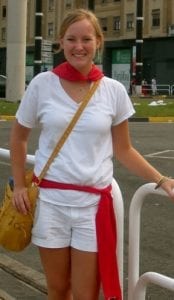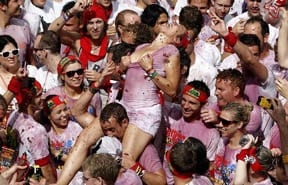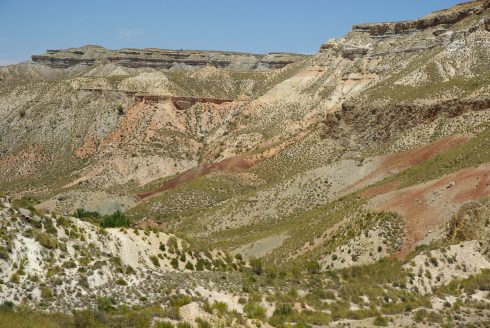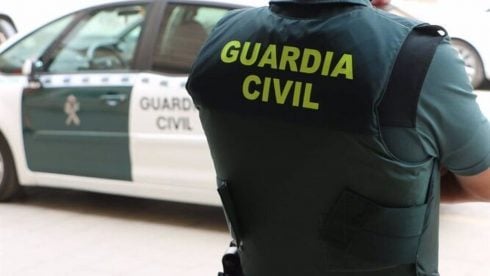By Sara Wallace
A BLUE shirt, in a sea of unrelenting white and red.
The second I walked out of the train station I knew I had made a mistake.

Of course I had done my homework and knew that people wore white at Pamplona’s famous San Fermin festival, but I had assumed I could change clothes once I found a nice, clean bathroom.
How wrong could I be as I meandered into one of the world’s biggest explosions of wanton excess – perhaps only matched by the carnival in Rio.
It felt like a giant game of ‘Where’s the Wally’ with everyone gawping at me inconspicuously.
I needed a quick change but with huge queues formed for each bathroom – the vast majority filthy – I had to duck behind a large tree to change into my white shirt.
A few minutes later with a red panuelo around my neck and a red scarf for my waist, I was just another speck in the crowd.
My solo trip to San Fermin – often known as the ‘Running of the Bulls’ – was a last-minute endeavour.
Working in the south of Spain this summer, I knew I couldn’t pass up the famous festival. I’m no bullfight freak like Ernest Hemingway, but I guess I was indeed another American curious to witness San Fermin’s antics firsthand.
When I mentioned my plans to my boyfriend across the pond and to the Spanish family with whom I live, they had their doubts.
A 20-year-old girl alone in the middle of what has been called a “massive drunken party of uncontrolled chaos”… it didn’t sound smart.
But you only live once, I figured, and I could hardly tell my bosses at the Olive Press that I was wimping out to spend the weekend on the beach.
The next problem was going to be getting a room. And quite simply there were none. Even 100 euros wouldn’t get you a crappy room in a hostel… so I would have to stay up all night and catch the bus home in the morning.
My train carriage from Madrid to Pamplona was a taste of what was to come. I sat next to a dozen Australian men on a stag weekend, who spent half the time playing a rowdy drinking game involving a leather whip!
On arrival, things seemed pretty normal. As I walked into town from the station I watched a band of pensioners play traditional Spanish songs, while parents strolled around with their panuelo-clad children. There were dancers, clowns, and mime artists throughout the streets.
But then I reached the park and caught a whiff of the celebrated ‘San Fermin stench’.
It was supper time, but here were around 50 people, all wearing white (well rather grubby and grey to be fair) passed out on blankets with huge empty vats of wine strewn around them.

By 10pm, I started to see a level of drunkenness I didn’t even know existed.
Most people in Andalucia seemed to drink in impressively respectable amounts (with Spain’s World Cup games being the exceptions, of course).
But this?….Well there wasn’t a better way to describe it than by saying it felt like an American ‘frat’ party, only worse. This was Animal House on the last day of school.
I saw a man in a wine-stained shirt, struggling to stand up while a gaggle of three girls in just their bras and knickers leaned on each other for support. On closer look I could see they had food smeared on their stomachs.
These people weren’t anomalies; in fact the vast majority were almost as drunk.
While not technically allowed to drink back home (21 is the limit in the USA), I am not adverse to the odd beer or three, but I had never seen drinking like this.
San Fermin revelers drink everything, but the festival’s drink of choice is Kalimoxto – red wine mixed with Coca-Cola, sometimes with an added splash of lemon.
People chug the dangerously delicious beverage with the heaviest of hands…. and later they try and run with bulls!

I eventually sat down at a café and lingered for as long as I could – clean seats without large crowds of sweaty men were hard to come by.
As I munched on my patatas bravas and swapped kalimoxto for a coffee to stay awake (over nine hours till the bull run!), I took in the scene.
Interspersed among the rowdy groups I noticed a few older, more respectable couples, drinking red wine and chatting normally. They dressed the part in white and red, but seemed resigned to the intensity and madness around them.
It was like they were attending a birthday celebration they didn’t really care about, but they were wearing party hats anyway.
The San Fermin festival must do wonders for Pamplona’s economy, but the sudden invasion of a million people over a week must be a shock to the system for the small provincial town of 200,000 people.
What is Pamplona like for the other 51 weeks of the year? Are the ten days something they look forward to with excitement, or dread?
According to some youths I talked to, dealing with the festival is all part of being from Pamplona. “It’s so crowded. If you’re running, you need to sleep. If you’re not, you need to watch out,” one of them told me.
As horrible as it sounds, I think we all, deep down, wanted some drama – maybe a goring or a person thrown gingerly into the air.
Good advice, I thought, as the café closed and I had to relinquish my shelter from the storm.
I thought about checking out one of the busy bars but was soon practically groped by two Spanish men yelling “Guapaaaa! Rubiaaaa!”
I moved quickly along and came upon a line of stands selling the foods every person fantasizes about when they have had a few drinks: churros covered in chocolate, sweet Nutella crepes, French fries, onion rings, and just plain balls of dough.
As I bought something deep-fried, my ears perked up and I heard something familiar.
Was that “R-E-S-P-E-C-T”?
Veiled by a heavy Spanish accent, indeed it was, and I followed the music to find a stage with a Spanish woman channeling Aretha Franklin for hoards of revelers.
When a Spanish version of Chuck Berry got up on stage it was time to move on.
By 3am, the filth was unavoidable.
I realized that the blue shirt wasn’t my biggest mistake after all…I looked around and realized I was the only one wearing flip-flops.
The cobblestone streets were smothered in a gooey layer of wine, water, dirt, broken glass, trash, piss, and who knows what else.
From three to five was the creepiest time to be walking around, particularly as a solo blonde.
It was like running the gauntlet as they came thick and fast.
“Rubia, are you alone? Come with us!” said one of them. I pointed in a random direction and said my amigos were ‘over there.’
Another persisted until I told him my novio was also ‘over there,’ and I made a gesture implying that he was a very strong man, not to be messed with.
When my watch clicked five, I decided it was time for a distinct mission – finding a good spot to watch the encierro, or bull run.
Legends say the first ‘bull run’ began in north-eastern Spain in the 14th century when cattle workers would use fear and excitement tactics to transport bulls to the market for sale.
A tradition was born and the practice grew competitive and young men would try to race in front of the bulls without getting injured.
Each day six bulls are released from the corral and run through the streets, goring whatever gets in their way and ending up in Pamplona’s Plaza de Toros.
Later that evening, they are killed in bullfights at the ring, and their meat is then served at restaurants in the Pamplona area and beyond.
Bulls that hurt no one are served up just the same way as the bull that ended up goring a man to death last year (the first encierro death coincidentally in 15 years).
The actual encierro route is hard to distinguish until around 5:30 am when officials install massive wooden fences to denote where the bulls will run.
I loitered just ahead of the spot known as ‘dead man’s corner’ – a 90-degree turn towards the end of the route where the 550 kg bulls are known to get confused and plough into runners.

With the help of two Texans (whom I would be sitting next to for the next three hours), I perched myself atop the massive fence.
First, police filled the area. Then came the emergency health personnel (tons of them!) and photographers.
Of the red-and-white clad runners many were clearly tourists; you could tell they were getting nervous as they checked their watches and craned their necks to look down the street.
Meanwhile, the Spanish experts – the ones who run next to the bulls and touch them – were laughing and chatting.
I saw a woman here and there among the runners, but was surprised by how few were eager to take part (perhaps this should be my next adventure).
Every now and then, police grabbed would-be runners by the arm and dragged them out of the running route if they appeared too inebriated to run.
I felt bad for one man who was deemed unfit, seemingly because he was too old.
Anyone should be able to run if he or she is determined enough, I thought. Hell, a 98-year-old ran a marathon in Athens last year!
But then I saw that his arm was bleeding for no reason, and I understood the policeman’s concern.
This was more than just a marathon.
In addition to avoiding the massive bulls that are confused and scared, half the challenge is to escape getting trampled by other runners.
The streets are slippery and there’s no predicting when a bull will slip, fall over and get separated from the pack.
When the first loud firecracker’s ‘boom’ went off at eight am to signal the bulls’ release from the corral, we immediately perked up.
When a second firecracker went off announcing that the last bull had left the corral, the runners got on their toes.
Suddenly, after three hours of waiting patiently, I saw a glint in one runner’s eyes as he spotted the first bull.
It was chaos and everyone was running for their lives as I saw glimpses of brown fur and a couple of horns poking up above the crowd.
But it was as if someone had just hit fast-forward through the best part of a movie, and the encierro was over as soon as it had begun.

The Texans and I stared at each other and couldn’t help but laugh. Is that what we had waited for?
As horrible as it sounds, I think we all, deep down, wanted some drama – maybe a goring or a person thrown gingerly into the air. At least something that necessitated all the doctors and ambulances.
But what we saw called only for a couple ice packs.
“Now what do we do?” asked one of the Texans. We hopped down and could barely walk; sitting on a wooden fence for three hours hurts more than you’d think.
I followed hoards of people to the bus station, and felt like I was trailing a pack of zombies. The bus station was an obstacle course of stepping over sleeping people.
My bus ride back home was the quietest ride I’ve ever taken. All the passengers were slumped over or leaning on each other’s shoulders for support, absolutely exhausted.
Resting against the window in my panuelo and white clothes, now dirty from my adventures, I fell asleep before I could count to ten.
Finally, I was starting to blend in.










Lol. Very good. Sums up Pamplona perfectly. You should have run though! Check out my vids of a couple of the runs here.
http://www.youtube.com/watch?v=4aRhkMM8wL4
Maybe you are in it Sarah?
An activity created by morons, for morons.
You havent done it Fred have you? Neither seen it nor taken part and that only gives you a perspective informed by other peoples bias.
I don’t need to do something to know it is wrong, Ben. Your logic is skewed. I suppose you are going to tell me next that the vote against bullfighting in Catelonia (https://theolivepress.es/2010/07/29/bullfighting-banned-in-catalonia/) was biased too?
Good riddance to this barbaric spectacle; it will slowly but surely be removed from Spain in a generation or sooner, hopefully.
It’s not neccessary that Ben answers. I’ll do by him. That vote is biased by what is considered spanish stink by independentists added to the weakness of Socialist Government needed of those votes to remain control on Catalonia.
I’m glad they are biased on this occasion then. Well done Catalonia.
Fred,
I’m leaving on holidays this evening and I wanted to forget my computer and rest from it. Thinking twice I’ll take it to answer your posts. Ignorance is no excuse.
Ignorance of the cruelty to a fellow creature is the issue here. People who support these spectacles in the name of “culture” had better get some new things to represent their cultural identity with.
It’s funny how this “independist” region comes over all good old fashioned castanet-clacking bull-fighting Francoist Spanish when it comes to Gibraltar though….
http://www.chronicle.gi/headlines_details.php?id=19614
And I don’t think the streets were quiet in Barcelona the night La Roja won so maybe Fred is right and Juan is wrong and this is actually about animal cruelty…
Yeah, we’ve heard your opinion Fred in your first post now you’re just boring. Bull running is not bull fighting.
Bull running, bull fighting, bull tormenting – whatever. If you’re bored, read another thread.
Good article. Sounds like Dublin on a wet saturday night……